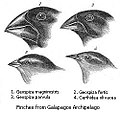Convergent evolution is the independent evolution of similar features in species of different periods or epochs in time. Convergent evolution creates...
57 KB (5,739 words) - 13:49, 18 August 2024
Convergent evolution—the repeated evolution of similar traits in multiple lineages which all ancestrally lack the trait—is rife in nature, as illustrated...
137 KB (14,866 words) - 19:17, 8 July 2024
Wayback Machine Zhang, J. and Kumar, S. 1997. Detection of convergent and parallel evolution at the amino acid sequence level Archived 2016-03-03 at the...
11 KB (1,167 words) - 20:06, 1 July 2024
refer to: Convergent boundary, a type of plate tectonic boundary Convergent (continued fraction) Convergent evolution Convergent series Convergent may also...
580 bytes (97 words) - 23:39, 22 October 2020
Evolutionary biology (redirect from Evolution (subfield))
Adaptive evolution can also be convergent evolution if two distantly related species live in similar environments facing similar pressures. Convergent evolution...
31 KB (3,423 words) - 11:01, 24 June 2024
Cephalopod (section Convergent evolution)
(2008). "Charting Evolution's Trajectory: Using Molluscan Eye Diversity to Understand Parallel and Convergent Evolution". Evolution: Education and Outreach...
138 KB (15,375 words) - 21:28, 9 July 2024
of evolution and is distinct from convergent evolution and parallel evolution, although it does share similarities with the other types of evolution. Convergent...
15 KB (1,631 words) - 01:03, 25 June 2024
Humanoid (section In theoretical convergent evolution)
sentient extraterrestrial lifeforms as humanoid as a byproduct of convergent evolution. Humanoid characters are defined by their human-like physical characteristics...
17 KB (2,009 words) - 17:26, 23 August 2024
Cephalopod eye (section Convergent evolution)
functionality. Contention exists on whether this is truly convergent evolution or parallel evolution. Unlike the vertebrate camera eye, the cephalopods' form...
11 KB (1,262 words) - 07:21, 23 August 2024
Carcinisation (category Convergent evolution)
Carcinisation (American English: carcinization) is a form of convergent evolution in which non-crab crustaceans evolve a crab-like body plan. The term...
20 KB (2,097 words) - 02:43, 10 August 2024
Sloth (redirect from Evolution of sloths)
sloths an example of convergent evolution to an arboreal lifestyle, "one of the most striking examples of convergent evolution known among mammals"....
50 KB (5,420 words) - 09:47, 15 August 2024
Snake (redirect from Snake evolution)
limbs or with greatly reduced limbs at least twenty-five times via convergent evolution, leading to many lineages of legless lizards. These resemble snakes...
151 KB (15,113 words) - 14:03, 3 August 2024
Electric fish (redirect from Evolution of electric fish)
electric field to remain stable for electrolocation. There has been convergent evolution in these features among the mormyrids and gymnotids. Electric fish...
31 KB (2,957 words) - 18:02, 8 August 2024
Common descent (section Convergent evolution)
Similarities which have no adaptive relevance cannot be explained by convergent evolution, and therefore they provide compelling support for universal common...
30 KB (3,067 words) - 22:25, 15 August 2024
Ungulate (redirect from Ungulate evolution)
striking example of convergent evolution. There is now some dispute as to whether this smaller Euungulata is a cladistic (evolution-based) group, or merely...
59 KB (5,867 words) - 17:19, 21 August 2024
common than transversions. The concept encompasses both convergent evolution and parallel evolution; it can be used to describe the observation of similar...
16 KB (2,025 words) - 03:00, 12 August 2024
System, reaching it can be accomplished with ordinary space travel. Convergent evolution is a biological concept whereby unrelated species acquire similar...
90 KB (12,931 words) - 00:19, 24 August 2024
Baculites (section Convergent evolution)
Baculites is an extinct genus of heteromorph ammonite cephalopods with almost straight shells. The genus, which lived worldwide throughout most of the...
17 KB (1,618 words) - 22:08, 7 April 2024
current niches. Apart from undergoing convergent evolution with plants, species of kelp have undergone convergent evolution within their own phylogeny that...
42 KB (5,140 words) - 07:37, 30 July 2024
Human skin color (redirect from Evolution of skin pigmentation)
"Genetic Evidence for the Convergent Evolution of Light Skin in Europeans and East Asians". Molecular Biology and Evolution. 24 (3): 710–22. doi:10.1093/molbev/msl203...
127 KB (14,244 words) - 23:22, 15 August 2024
Marsupial (redirect from Evolution of marsupials)
placental mammals and are examples of convergent evolution. This convergence is evident in both brain evolution and behaviour. The extinct thylacine strongly...
75 KB (7,760 words) - 00:21, 14 August 2024
selection of behavioural skills provides a typical environment for convergent evolution. There is a wide range of shared general and specific social skills...
27 KB (3,185 words) - 19:54, 15 June 2024
Mustelidae (redirect from Evolution of mustelids)
Because mongooses and mustelids occupy similar ecological niches, convergent evolution has led to similarity in form and behavior. Several mustelids, including...
23 KB (2,031 words) - 04:44, 31 July 2024
A convergent boundary (also known as a destructive boundary) is an area on Earth where two or more lithospheric plates collide. One plate eventually slides...
20 KB (2,374 words) - 05:34, 23 May 2024
Viviparity (redirect from Evolution of viviparity)
viviparous modes of reproduction; selective pressures have led to its convergent evolution more than 150 times among the vertebrates alone. There is no one...
17 KB (1,972 words) - 23:38, 9 July 2024
Feliformia (redirect from Evolution of feliform mammals)
has four extant species and two subspecies. All show features of convergent evolution with canids, including non-retractile claws, long muzzles, and adaptations...
22 KB (2,185 words) - 16:54, 7 July 2024
evolved in many different birds independently, demonstrating repeated convergent evolution. There were families of flightless birds, such as the now-extinct...
38 KB (3,850 words) - 20:12, 17 June 2024
realm, toucans occupy the hornbills' ecological niche, an example of convergent evolution. Despite their close appearances, the two groups are not very closely...
34 KB (3,742 words) - 23:39, 20 August 2024
proboscis while hovering in the air; this resemblance is an example of convergent evolution. The hummingbird hawk-moth was first described by Carl Linnaeus in...
18 KB (1,888 words) - 12:59, 14 August 2024
features known as homoplasies, which are explained as a result of convergent evolution. The arrangement of the members of a polyphyletic group is called...
11 KB (1,112 words) - 07:33, 9 February 2024
























